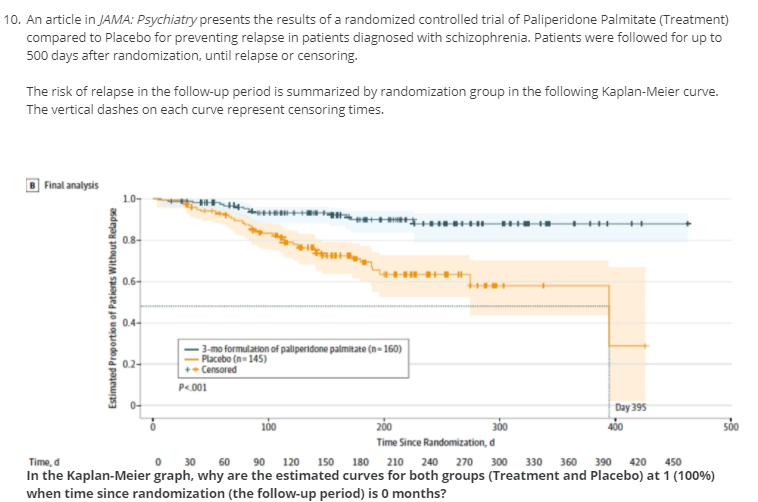In the Kaplan-Meier graph, why are the estimated curves for both groups (Treatment and Placebo) at 1 (100%) when time since randomization (the follow-up period) is 0 months?
In the Kaplan-Meier graph, why are the estimated curves for both groups (Treatment and Placebo) at 1 (100%) when time since randomization (the follow-up period) is 0 months?
Nutrition Through The Life Cycle
7th Edition
ISBN:9781337919333
Author:Brown, Judith E.
Publisher:Brown, Judith E.
Chapter18: Nutrition And Older Adults
Section: Chapter Questions
Problem 1RQ
Related questions
Question
its public health statistics only answer needed

Transcribed Image Text:10. An article in JAMA: Psychiatry presents the results of a randomized controlled trial of Paliperidone Palmitate (Treatment)
compared to Placebo for preventing relapse in patients diagnosed with schizophrenia. Patients were followed for up to
500 days after randomization, until relapse or censoring.
The risk of relapse in the follow-up period is summarized by randomization group in the following Kaplan-Meier curve.
The vertical dashes on each curve represent censoring times.
Final analysis
1.0-
0.8-
0.6-
0.4-
3-mo formulation of paliperidone palmitate (n-160)
Placebo (n- 145)
++ Censored
0.2-
P<001
0-
Day 395
100
200
300
400
500
Time Since Randomization, d
Time, d
30
60
90
120
150
180
210
240
270
300
330
360
390
420
450
In the Kaplan-Meier graph, why are the estimated curves for both groups (Treatment and Placebo) at 1 (100%)
when time since randomization (the follow-up period) is 0 months?
Estimated Proportion of Patients Without Relapse

Transcribed Image Text:Because the follow-up period is less than 2 years.
Because 100% of the subjects relapsed at 0 months of follow-up.
Because 100% of the subjects were censored by the end of the study.
Because all subjects followed in this study were event free (had not yet relapsed) at the beginning of the study
Expert Solution
This question has been solved!
Explore an expertly crafted, step-by-step solution for a thorough understanding of key concepts.
Step by step
Solved in 3 steps

Knowledge Booster
Learn more about
Need a deep-dive on the concept behind this application? Look no further. Learn more about this topic, nursing and related others by exploring similar questions and additional content below.Recommended textbooks for you

Nutrition Through The Life Cycle
Health & Nutrition
ISBN:
9781337919333
Author:
Brown, Judith E.
Publisher:
Cengage Learning,

Understanding Health Insurance: A Guide to Billin…
Health & Nutrition
ISBN:
9781337679480
Author:
GREEN
Publisher:
Cengage

Essentials Health Info Management Principles/Prac…
Health & Nutrition
ISBN:
9780357191651
Author:
Bowie
Publisher:
Cengage

Nutrition Through The Life Cycle
Health & Nutrition
ISBN:
9781337919333
Author:
Brown, Judith E.
Publisher:
Cengage Learning,

Understanding Health Insurance: A Guide to Billin…
Health & Nutrition
ISBN:
9781337679480
Author:
GREEN
Publisher:
Cengage

Essentials Health Info Management Principles/Prac…
Health & Nutrition
ISBN:
9780357191651
Author:
Bowie
Publisher:
Cengage

Case Studies In Health Information Management
Biology
ISBN:
9781337676908
Author:
SCHNERING
Publisher:
Cengage
